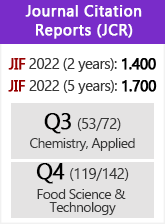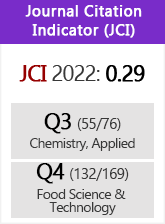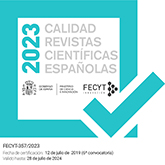Use of polar and nonpolar fractions as additional information sources for studying thermoxidized virgin olive oils by FTIR
DOI:
https://doi.org/10.3989/gya.121913Keywords:
FTIR spectroscopy, Polar and nonpolar fractions, Thermoxidation, Virgin olive oilAbstract
Fourier transform infrared (FTIR) spectroscopy has been proposed to study the degradation of virgin olive oils (VOO) in samples undergoing thermoxidation. The polar and nonpolar fractions of oxidized oils have been analyzed by FTIR to provide further information on the minor spectral changes taking place during thermoxidation. This information assists in the interpretation of the spectra of the samples. For this purpose polar and nonpolar fractions of 47 VOO samples thermoxidized (190 °C) in a fryer were analyzed by FTIR. The time-course change of the band area assigned to single cis double bonds was explained by their correlation with the decrease in oleic acid (adjusted-R2=0.93). The bands assigned to the hydroxyl groups and the first overtone of ester groups was better studied in the spectra collected for the polar and nonpolar fractions, respectively. The bands assigned to peroxide, epoxy, tertiary alcohols and fatty acids were clearly observed in the spectra of the polar fraction while they are not noticeable in the spectra of the oils.
Downloads
References
Baeten V, Fernandez Pierna JA, Dardenne P, Meurens M, García-González DL, Aparicio-Ruiz R. 2005. Detection of the presence of hazelnut oil in olive oil by FT-Raman and FT-MIR spectroscopy. J. Agric. Food Chem. 53, 6201–6206. http://dx.doi.org/10.1021/jf050595n PMid:16076094
Barrera-Arellano D, Ruiz-Méndez V, Velasco J, Márquez-Ruiz G, Dobarganes C. 2002. Loss of tocopherols and formation of degradation compounds at frying temperatures in oils differing in degree of unsaturation and natural antioxidant content. J. Sci. Food Agric. 82, 1696–1702. http://dx.doi.org/10.1002/jsfa.1245
Billek G. 2000. Health aspects of thermoxidized oils and fats. Eur. J. Lipid Sci. Technol. 102, 587–593. http://dx.doi.org/10.1002/1438-9312(200009)102:8/9<587::AID-EJLT587>3.0.CO;2-#
Bordeaux O, Márquez-Ruiz G, Dobarganes MC. 1999. Characterization, quantitation and evolution of monoepoxy compounds formed in model systems of fatty acid methyl esters and monoacid triglycerides heated at high temperature. Grasas Aceites 50, 53–59. http://dx.doi.org/10.3989/gya.1999.v50.i1.636
Caldwell JD, Cooke BS, Greer MK. 2011. High performance liquid chromatography-size exclusion chromatography for rapid analysis of total polar compounds in used frying oils. J. Am. Oil Chem. Soc. 88, 1669–1674. http://dx.doi.org/10.1007/s11746-011-1845-5
Casal S, Malheiro R, Sendas A, Oliveira BPP, Pereira JA. 2010. Olive oil stability under deep-frying conditions. Food Chem. Toxicol. 48, 2972–2979. http://dx.doi.org/10.1016/j.fct.2010.07.036 PMid:20678538
Christophoridou S, Dais P. 2009. Detection and quantification of phenolic compounds in olive oil by high resolution 1H nuclear magnetic resonance spectroscopy. Anal. Chim. Acta 633, 283–292. http://dx.doi.org/10.1016/j.aca.2008.11.048 PMid:19166735
Coates J. 2000. Interpretation of infrared spectra, a practical approach. In: R.A. Meyers (Ed.) Encyclopedia of Analytical Chemistry. John Wiley & Sons Ltd.: Chichester, U.K. pp. 1–23.
Dobarganes MC, Márquez-Ruiz G. 1998. Analytical evaluation of fats and oils by size-exclusion chromatography. Analysis 26, 61–65. http://dx.doi.org/10.1051/analusis:199826030061
Dobarganes MC, Pérez-Camino MC. 1988. Fatty acid composition: a useful tool for the determination of alteration level in heated fats. Rev. Fr. Corps Gras 35, 67–70.
Dobarganes MC, Velasco J, Dieffenbacher A. 2000. Determination of polar compounds, polymerized and oxidized triacylglycerols, and diacylglycerols in oils and fats – Results of collaborative studies and the standardized method (Technical Report). Pure Appl. Chem. 72, 1563–1575. http://dx.doi.org/10.1351/pac200072081563
Friedman M, Levin CE. 2008. Review of methods for the reduction of dietary content and toxicity of acrylamide. J. Agric. Food Chem. 56, 6113–6140. http://dx.doi.org/10.1021/jf0730486 PMid:18624452
García-González DL, Aparicio-Ruiz R, Aparicio R. 2009. Olive oil. In Gourmet and Health-Promoting Oils; Kamal- Eldin A, Moreaou R (Ed.) AOCS press: Champaign, IL, pp. 33–72.
Innawong B, Mallikarjunan P, Marcy JE. 2004. The determination of frying oil quality using a chemosensory system. Food Sci. Technol.-Leb. 37, 35–41.
Ismail AA, Nicodemo A, Sedman J, van de Voort F, Holzbaur IE. 1999. Infrared spectroscopy of lipids: Principles and applications. In Spectral Properties of Lipids; Hamilton, RJ, Cast, J (Ed.) CRC Press: Boca Raton, FL. pp. 235–269.
IUPAC 2.507. 1992. International Union of Pure and Applied Chemistry (IUPAC). Determination of polar compounds in frying fats. In Standard Methods for the Analysis of Oils, Fats and Derivatives, (7th ed.). Blackwell: Oxford, U.K.
Li Y, García-González DL, Yu X, van de Voort FR. 2008. Determination of free fatty acids in edible oils with the use of a variable filter array IR spectrometer. J. Am. Oil Chem. Soc. 85, 599–604. http://dx.doi.org/10.1007/s11746-008-1232-z
Marmesat S, Velasco J, Marquez-Ruiz G, Dobarganes MC. 2007. A rapid method for determination of polar compounds in used frying fats and oils. Grasas Aceites 58, 179–184.
Mateos R, Espartero JL, Trujillo M, Ríos JJ, León-Camacho M, Alcudia F, Cert A. 2001. Determination of phenols, flavones, and lignans in virgin olive oils by solid-phase extraction and high-performance liquid chromatography with diode array ultraviolet detection. J. Agric. Food Chem. 49, 2185–2192. http://dx.doi.org/10.1021/jf0013205 PMid:11368575
Moya Moreno MCM, Mendoza Olivares D, Amézquita López FJ, Gimeno Adelantado JV, Bosch Reig F. 1999. Analytical evaluation of polyunsaturated fatty acids degradation during thermal oxidation of edible oils by Fourier transform infrared spectroscopy. Talanta 50, 269–275. http://dx.doi.org/10.1016/S0039-9140(99)00034-X
Piper R. 2001. The market for fried food. In Frying: Improving Quality; Rossell JB. (Ed.) CRC Press: Boca Raton, FL, pp. 7–16. http://dx.doi.org/10.1533/9781855736429.1.7
Romero A, Cuesta C, Sánchez-Muniz FJ. 1998. Effect of oil replenishment during deep-fat frying of frozen foods in sunflower oil and high-oleic acid sunflower oil. J. Am. Oil Chem. Soc. 75, 161–167. http://dx.doi.org/10.1007/s11746-998-0028-5
Russin TA, van de Voort FR, Sedman J. 2003. Novel method for rapid monitoring of lipid oxidation by FTIR spectroscopy using disposable IR cards. J. Am. Oil Chem. Soc. 80, 635–641. http://dx.doi.org/10.1007/s11746-003-0751-8
Sanibal EAA, Mancini-Filho J. 2004. Frying oil and fat quality measured by chemical, physical, and test kit analyses. J. Am. Oil Chem. Soc. 81, 847–852. http://dx.doi.org/10.1007/s11746-004-0990-8
Scano P, Rosa A, Cesare Marincola F, Locci E, Melis MP, Dessì MA, Lai A. 2008. 13C NMR, GC and HPLC characterization of lipid components of the salted and dried mullet (Mugil cephalus) roe "bottarga". Chem. Phys. Lipids 151, 69–76. http://dx.doi.org/10.1016/j.chemphyslip.2007.10.001 PMid:17996196
Sedman J, van de Voort FR, Ismail AA, Maes P. 1998. Industrial validation of FTIR trans and iodine value analyses of fats and oils. J. Am. Oil Chem. Soc. 75, 33–39. http://dx.doi.org/10.1007/s11746-998-0006-y
Smith JW, Victoria MC. 1968. Infrared spectroscopic investigations of acid-base interactions in aprotic solvents. Part I. The interaction of tri-n-propylamine and some carboxylic acids. J. Chem. Soc. A, 2468–2474. http://dx.doi.org/10.1039/j19680002468
Stier RF. 2001. The measurement of frying oil quality and authenticity. In Frying: Improving Quality; Rossell JB (Ed.) CRC Press: Boca Raton, FL, pp. 7–16.
Tabachnick BG, Fidell LS. 1983. Using multivariate Statistics. New York: Harper & Row.
Tena N, Aparicio R, García-González DL. 2009. Thermal deterioration of virgin olive oil monitored by ATR-FTIR analysis of trans content. J. Agric. Food Chem. 57, 9997–10003. http://dx.doi.org/10.1021/jf9012828 PMid:19817451
Valavanidis A, Nisiotou C, Papageorgiou Y, Kremli I, Satravelas N, Zinieris N, Zygalaki H. 2004. Comparison of the radical scavenging potential of polar and lipidic fractions of olive oil and other vegetable oils under normal conditions and after thermal treatment. J. Agric. Food Chem. 52, 2358–2365. http://dx.doi.org/10.1021/jf030491h PMid:15080646
van de Voort FR, Sedman J, Russin T. 2001. Lipid analysis by vibrational spectroscopy. Eur. J. Lipid Sci. Technol. 103, 815–840. http://dx.doi.org/10.1002/1438-9312(200112)103:12<815::AID-EJLT1111815>3.0.CO;2-P
van de Voort FR, Ghetler A, García-González DL, Li Y. 2008a. Perspectives on Quantitative Mid-FTIR spectroscopy in relation to edible oil and lubricant analysis: evolution and integration of analytical methodologies. Food Anal. Meth. 1, 153–163. http://dx.doi.org/10.1007/s12161-008-9031-6
van de Voort FR, Ismail AA, Sedman J, Dubois J, Nicodemo T. 1994. The determination of peroxide value by Fourier transform infrared spectroscopy. J. Am. Oil Chem. Soc. 71, 921–926. http://dx.doi.org/10.1007/BF02542254
van de Voort FR, Sedman J, Sherazi STH. 2008. Correcting for underlying absorption interferences in Fourier transform infrared trans analysis of edible oils using two-dimensional correlation techniques. J. Agric. Food Chem. 56, 1532–1537. http://dx.doi.org/10.1021/jf0725068 PMid:18266316
Velasco, J, Dobarganes, MC. 2002. Oxidative stability of virgin olive oil. Eur. J. Lipid Sci. Technol. 104, 661–676. http://dx.doi.org/10.1002/1438-9312(200210)104:9/10<661::AID-EJLT661>3.0.CO;2-D
Velasco J, Marmesat S, Márquez-Ruiz G, Dobarganes MC. 2004. Formation of short-chain glycerol-bound oxidation products and oxidised monomeric triacylglycerols during deep-frying and occurrence in used frying fats. Eur. J. Lipid Sci. Technol. 106, 728–735. http://dx.doi.org/10.1002/ejlt.200401032
Yu X, van de Voort FR, Sedman J. 2007. Determination of peroxide value of edible oils by FTIR spectroscopy with the use of the spectral reconstitution technique. Talanta 74, 241–246. http://dx.doi.org/10.1016/j.talanta.2007.06.004 PMid:18371636
Zhang Q, Saleh ASM, Chen J, Shen Q. 2012. Chemical alterations taken place during deep-fat frying based on certain reaction products: A review. Chem. Phys. Lipids 165, 662–681. http://dx.doi.org/10.1016/j.chemphyslip.2012.07.002 PMid:22800882
Zamora R, Gómez G, Dobarganes MC, Hidalgo FJ. 2002a. Oil fractionation as a preliminary step in the characterization of vegetable oils by high-resolution 13C NMR spectroscopy. J. Am. Oil Chem. Soc. 79, 261–266. http://dx.doi.org/10.1007/s11746-002-0471-0
Zamora R, Gómez G, Hidalgo FJ. 2002b. Classification of vegetable oils by high-resolution 13C NMR spectroscopy using chromatographically obtained oil fractions. J. Am. Oil Chem. Soc. 79, 267–272. http://dx.doi.org/10.1007/s11746-002-0472-z
Published
How to Cite
Issue
Section
License
Copyright (c) 2014 Consejo Superior de Investigaciones Científicas (CSIC)

This work is licensed under a Creative Commons Attribution 4.0 International License.
© CSIC. Manuscripts published in both the printed and online versions of this Journal are the property of Consejo Superior de Investigaciones Científicas, and quoting this source is a requirement for any partial or full reproduction.All contents of this electronic edition, except where otherwise noted, are distributed under a “Creative Commons Attribution 4.0 International” (CC BY 4.0) License. You may read here the basic information and the legal text of the license. The indication of the CC BY 4.0 License must be expressly stated in this way when necessary.
Self-archiving in repositories, personal webpages or similar, of any version other than the published by the Editor, is not allowed.
















